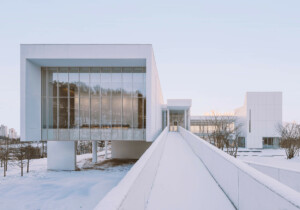South Korean film director Bong Joon-ho has, in recent years, become an increasingly notable figure among those in the global film community. His latest work, Parasite (2019), expertly straddles the line between art-house and popcorn thriller as it tells the story of a destitute family of four, the Kims, conning a much wealthier family, the Parks, into full employment by posing as unrelated professionals in the service industry and integrating themselves into the richer family’s lives. While its protagonists excel at filling each scene with elegant dialogic tension and balletic physical gestures throughout, it is the film’s architecture and general production design that ultimately both deepens and carries the film’s plot to its tragic resolution (note: this review contains no spoilers).
The Kims live in a cramped semi-basement with a casement window at the dead-end of a dreary alleyway as their only natural light source. When Kim Ki-woo, the family’s son, is invited to the Park home to interview under the pretense of being a university-level English tutor, he – and us, in turn – are stunned by how the other half lives. He approaches the property via a tidy, narrow street with a fortress-like wall punctuated by a heavy steel door. Ki-woo pushes it open to ascend a sweep of exterior stairs leading to a grand courtyard garden that seems only a dash smaller and less guarded than Versailles. An immaculate modern-style home overlooks the courtyard with streak-free floor-to-ceiling windows, through which Ki-woo sees an expansive, multi-level interior.
The spatial layout of the Kims’ semi-basement home “really reflects the psyche of the Kim family,” Bong explained in an interview. “You’re still half overground, so there’s this hope and this sense that you still have access to sunlight and you haven’t completely fallen to the basement yet. It’s this weird mixture of hope and this fear that you can fall even lower. I think that really corresponds to how the protagonists feel.” And while the audience is told that the Parks’ sprawling home and grounds were designed by Namgoong Hyeonja, a fictional architect that built the home for himself before vacating four years ago, they were, in actuality, an elaborate stage set built specifically for the film. Production designer Lee Ha-joon revealed that the first floor and garden were built in an empty lot, while the austere interior spaces were built on a soundstage. “We had to consider the cinematic factors,” Lee explained, “but also had to create a house so real that the audience could accept the idea the characters were actually living in it.”
The film cuts back and forth between the opulent simplicity of the Park residence and the tightly-packed squalor of the Kim home as the protagonists argue that rich people are nice because they can afford to be. “Hell, if I had all this money,” says Kim Chung-sook, the family’s mother, as she gestures to the cavernous, sparsely-decorated interior of the Park residence, “I’d be nice, too!” Throughout Parasite, wealth presents itself in the form of architectural design that is serene yet equal parts boastful and territorial, while its more prevalent and common opposite is indeterminate, circumstantial and perpetually cluttered. Private, empty space, the film convinces us, is a rare luxury in itself.











